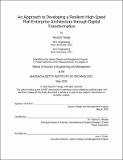An approach to developing a resilient high-speed rail enterprise architecture through digital transformation
Author(s)
Takagi, Ryuichi (Scientist in system design and management) Massachusetts Institute of Technology.
Download1263350877-MIT.pdf (4.507Mb)
Other Contributors
Massachusetts Institute of Technology. Engineering and Management Program.
System Design and Management Program.
Terms of use
Metadata
Show full item recordAbstract
Japanese Shinkansen has been a safe and reliable mode of transportation in Japan, and JR-Central has developed a well-organized operating system architecture to ensure safety, reliability, and profitability. However, now is the time for the company to transform its architecture because the landscape surrounding the enterprise and stakeholders' needs are rapidly changing. For instance, a lifetime employment custom, which was the long-established practice in large Japanese firms, is disappearing, and the mindset of younger workers in career development can change. Digital technology, which changes general business and the way of working, is available and applicable to all industries. While the Shinkansen system has been successful thus far, the enterprise needs to develop a future architecture that fits with those trends and environments. The objective of this study is to investigate and generate a resilient Shinkansen enterprise architecture against the changes in landscape and stakeholders' needs by implementing digital transformation. The thesis uses the ARIES framework to analyze capabilities of the current enterprise architecture and identify points that require transformation. In addition, literature review and case studies are performed to identify key characteristics to proceed with digital transformation, organizational transformation, and talent management. On the basis of the analyses and literature review, this thesis generates alternative architectures that meet emerging stakeholders' needs and fit the changing landscape of JR-Central. Furthermore, the alternatives are evaluated in context of several extreme scenarios, including the worst-case scenario due to impacts from COVID-19. The results indicate that an alternative architecture that consists of small internal IT and HR units, external intrapreneurs, and corporate venture capital is the best in terms of resiliency. The thesis also provides an implementation plan for an architecting team of JR-Central. The result of this research can be utilized to design a resilient architecture to maintain its safe and reliable Shinkansen operation and create values to survive and grow in the changing landscape and uncertain future in the Japanese railway industry.
Description
Thesis: S.M. in Engineering and Management, Massachusetts Institute of Technology, System Design and Management Program, May, 2020 Cataloged from the official version of thesis. Includes bibliographical references (pages 136-140).
Date issued
2020Department
Massachusetts Institute of Technology. Engineering and Management ProgramPublisher
Massachusetts Institute of Technology
Keywords
Engineering and Management Program., System Design and Management Program.